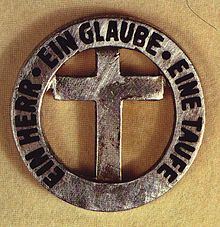Baptism of believers
The baptism of believers (also: baptism of faith or, less precisely, baptism of adults , adolescents and coming of age ) is a baptism of people who desire their own baptism.
It is the rule in many Baptism-minded churches, free churches and Christian communities. In contrast, the major German churches and some free churches also baptize children who are not yet able to express their faith themselves at the request of the parents, who, together with the godparents, promise to raise the baptized in the Christian faith (see child baptism ). At the same time, however, adult baptism is also practiced in the latter among unbaptized applicants who are religiously responsible.
To the subject
In churches that baptize both adults and children, the term “adult baptism” as opposed to “infant baptism” is used rather than the term “believer baptism”. Churches and communities that primarily practice Christian baptism, however, reject the term “adult baptism” because it suggests that a baptismal candidate can only be baptized after they have reached adulthood. Even the churches, in which the term adult baptism is common, make the baptism of a person dependent not on his age, but always on the confession of Jesus Christ . In the form of adult baptism, they also give baptism to children and young people who have reached the “age of discernment” (ie as soon as they can distinguish between good and bad) and can thus profess their personal faith.
In interdenominational conversations, for example between Baptists and Mennonites with Lutherans , the question is discussed in this context whether the person to be baptized's personal faith is constitutive for the validity of baptism.
overview
Adolescent and adult baptisms are practiced in all Christian churches. In the national churches in Germany they are proportionally much lower than child baptisms . In the Catholic Church , the baptism of schoolchildren, who are canonically regarded as adults, of adolescents and adults, is usually preceded by a year of preparation, the catechumenate .
In many free churches, such as the Baptists, the Brethren congregations , the Free Evangelical congregations , the congregations of Christ , the Mennonites, the Pentecostal congregations , the Seventh-day Adventists , the baptism of believers after instruction in the faith and Bible study is the rule ( see also Baptism-minded ). It usually takes place here as a full-body baptism based on the biblical model .
Some of the free churches mentioned do not recognize infant baptism as a valid Christian baptism because it lacks the person being baptized's personal creed as an essential quality feature. These free churches include a. the Baptists, some Mennonite, Pentecostal, and Adventist churches. Critics see the so-called re-baptism in the rebaptism practiced by these groups as a child .
The Jehovah's Witnesses , the Christadelphians, and the Mormons also reject infant baptism. The non-Trinitarian baptisms performed by them are, however, usually not recognized as Christian baptisms by the other churches.
history
In the New Testament only baptisms of faith are explicitly reported, whereby it cannot be ruled out that children were also included in the house baptisms in the New Testament . In the early Church, infant baptism was established as the norm. Adult baptisms occurred mainly when converting from another religion to Christianity, but also among descendants of Christian parents such as Augustine (baptism postponement). In the course of Christian missions , there were also limited forced baptisms .
Efforts have been in favor of believers' baptism since the 16th century. During the Reformation it was the Anabaptist movement from which the Mennonites, Amish and Hutterites emerged . The early Unitarians in Poland-Lithuania were also Anabaptist. The Baptists , who emerged from English Puritanism , were formed in the 17th century and the Tunkers , who emerged from Radical Pietism , followed in the 18th century . Later other churches and free churches like the Adventists were added. But even in Protestant churches that practice infant baptism, there has been an increasing number of baptisms of adolescents and adults since the second half of the 20th century. In the secularized societies of Europe, adult baptism is again playing a greater role because many people no longer belong to a Christian church and many children were not baptized as a result.
Churches with the baptism of believers
Churches that today only practice Trinitarian baptism include:
- Baptists such as the Union of Evangelical Free Churches
- Brethren Movement
- Free Evangelical Churches
- Church of God (FBGG)
- Churches of Christ
- Hutterites
- Mennonites such as the working group of Mennonite congregations in Germany
- Pentecostal Movement
- Seventh-day Adventists
Antitrinitarians with Christian baptism are:
literature
- Wolfram Kerner: Believer Baptism and Infant Baptism. Studies on Baptism and Mutual Baptism Recognition in Newer Protestant Theology. Books on Demand, Norderstedt 2004, ISBN 3-8334-2174-6 (At the same time dissertation at the University of Heidelberg 2004 under the title: Believer Baptism, Infant Baptism and Mutual Recognition of Baptism ).
